Author: Jake Huolihan
I’ve changed a lot in the way I brew– the particular methods I use, things I find important, and definitely the styles I enjoy making and drinking. Whereas I used to brew Double IPA and Imperial Stout almost exclusively, my preference has evolved to include more nuanced, delicate lagers. I’ll always enjoy a good IPA, but there’s something special about the crisp malty goodness of classic lager styles like Vienna and Pils that have stolen my heart.
Unfortunately, making lager tends to require more effort than ale, at least when conventional methods are employed. In addition to increased boil, fermentation, and conditioning times, it’s generally recommended that a substantial amount of yeast be pitched to ensure a healthy fermentation at cooler temperatures, sometimes as much as quadruple the amount recommended for ale. This can be accomplished by purchasing more yeast, though it’s likely most prefer saving some coin by propagating yeast in a starter, typically requiring a large flask and lots of malt extract. Moreover, many brewers choose to crash these larger volume starters once fermentation is complete and decant the supernatant before pitching to avoid potential off-flavors. Whereas I tend to make ale starters a day or so before pitching, I have to get my lager starters going nearly a week in advance to account for all of these steps. Is there a better way?
Results from the first xBmt on vitality starters inspired me to give the method a shot and many successful uses I’ve fully embraced it. In contrast to standard starters focused on viability, the purpose of a vitality starter is to ensure the yeast is healthy and active when pitched. They’re also quite convenient since they require significantly less wort and only 4 hours on the stir plate. However, I’ve been apprehensive about using a vitality starter in a lager due to my dogmatic adherence to the idea such cool fermented styles require a greater amount of cells. Curiosity eventually won out, and with some gentle encouragement from the crew, I decided to put it to the test!
| PURPOSE |
To evaluate the differences between a split-batch of the same lager beer pitched with either a vitality starter or a viability starter.
| METHODS |
![]() From the beautiful city of České Budějovice in the Czech Republic stems an equally as beautiful Bohemian Pilsner that became a personal favorite of mine while visiting the region, Budějovický Budvar, aka Budweiser Budvar or simply Budvar. Wanting to have something close to Budvar on tap at home, I designed a simple recipe using WLP802 Czech Budejovice Lager yeast and bought two packs with same manufacture date.
From the beautiful city of České Budějovice in the Czech Republic stems an equally as beautiful Bohemian Pilsner that became a personal favorite of mine while visiting the region, Budějovický Budvar, aka Budweiser Budvar or simply Budvar. Wanting to have something close to Budvar on tap at home, I designed a simple recipe using WLP802 Czech Budejovice Lager yeast and bought two packs with same manufacture date.
This Budvar’s For You
Recipe Details
| Batch Size | Boil Time | IBU | SRM | Est. OG | Est. FG | ABV |
|---|---|---|---|---|---|---|
| 11 gal | 60 min | 33.5 IBUs | 4.5 SRM | 1.054 | 1.010 | 5.8 % |
| Actuals | 1.054 | 1.009 | 5.9 % | |||
Fermentables
| Name | Amount | % |
|---|---|---|
| Pilsner (2 row) (Gambrinus) | 24 lbs | 99.84 |
| Black (Patent) Malt | 0.6 oz | 0.16 |
Hops
| Name | Amount | Time | Use | Form | Alpha % |
|---|---|---|---|---|---|
| Saaz | 65 g | 60 min | Boil | Pellet | 4.2 |
| Saaz | 90 g | 30 min | Boil | Pellet | 4.2 |
Yeast
| Name | Lab | Attenuation | Temperature |
|---|---|---|---|
| Czech Budejovice Lager (WLP802) | White Labs | 78% | 50°F - 55°F |
Download
| Download this recipe's BeerXML file |
Four days before brewing, I determined the appropriate volume for the viability starter using my preferred yeast calculator. To achieve the suggested count of approximately 400 billion cells, I pitched a single pack of WLP802 into 2700 mL of starter wort.
I began cold crashing the starter after about 36 hours, as signs of fermentation were no longer present. I collected the ingredients and water the night before brewing then awoke early the next morning and got to work. Once the strike water was heated to the appropriate temperature, I mashed in to hit my target temperature.
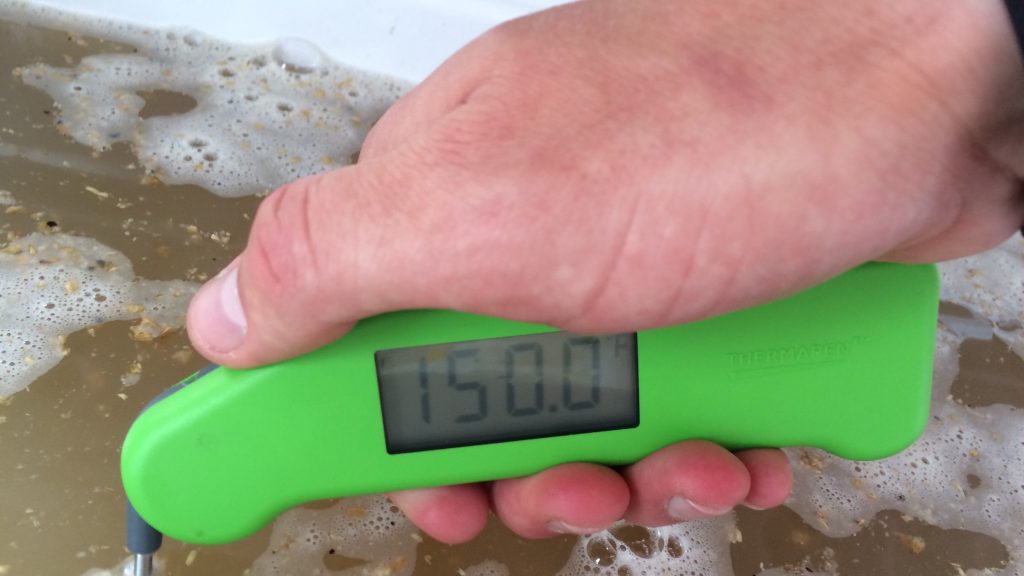
Following a 60 minute rest, I performed the batch sparge method to collect the full volume of sweet wort.
I proceeded to boil the wort for 90 minutes, during which hops were added according to the recipe.
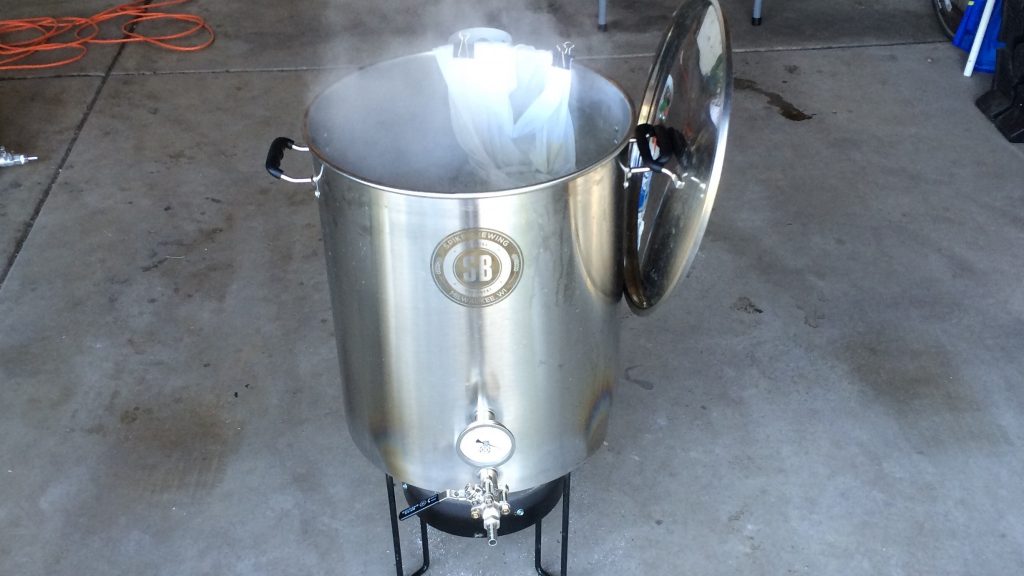
With the boil complete, I quickly chilled the wort to a respectable 62°F/17°C then split it equally between two 6 gallon PET carboys.
A hydrometer sample at this point revealed the wort was at 1.054 OG. The full carboys were placed in my fermentation chamber to continue chilling to my desired pitching temperature of 49°F/9°C. Since I wanted the vitality starter to be on the stir plate for only 4 hours, I waited until the wort was 53°F/12°C before preparing it, which involved pitching the other pack of yeast into a mere 500 mL of starter wort then placing it on my stir plate.
Both batches had dropped to my target fermentation temperature by the time the vitality starter was ready. Based on instructions from Colin Kaminski, from whom we learned of this method, only the wort that would be pitched with the viability starter was hit with pure O2. In fact, the vitality starter method is specifically designed to eliminate the need for oxygenation. After decanting the viability starter, I pitched both into their respective worts. Then my wife and I left for a weekend fly fishing trip in the mountains. When I returned 2 days later, I was startled to see things weren’t going as expected based on my many previous experiences with vitality starters in ales.
I frantically checked brew day photos to ensure I hadn’t pitched both flasks into the same carboy in my rush to pack for camping. Realizing this was likely a function of the variable in question, I committed to documenting the fermentation progress in more detail than I usually do. After giving the vitality starter beer an extra day before I did anything rash, I was rewarded with signs of fermentation, whew! By 3 days in, the vitality batch was starting to show signs of life, which pathetic as it was, eased some of my worries.
A day later, the vitality beer maintained a somewhat darker appearance than the viability batch, which I interpreted as a potential indication of a sluggish fermentation.
Finally, at 9 days post-pitch, both batches looked the same.
Out of curiosity, I took hydrometer readings 12 days into fermentation that showed the viability beer had reached 1.013 SG while the vitality starter was sitting at 1.032 SG. I usually raise the temperature after about a week of fermentation for my lagers, but chose to keep these beers cool in hopes of emphasizing any differences caused by the variable. I took more hydrometer readings 10 days later and found the viability beer had reached the expected 1.008 FG while the vitality beer was still at 1.013 SG. Thankfully, neither sample had any hint of off flavors, in fact, I was pleased with the flavor of both. I began gently nudging the temperature in the chamber up to 60°F/16°F in hopes of encouraging the vitality beer to finish fermenting. Finally, after 30 fucking days, the beer pitched with the vitality starter had dropped to 1.009 FG and signs of fermentation were absent; the viability beer was still at 1.008 FG.
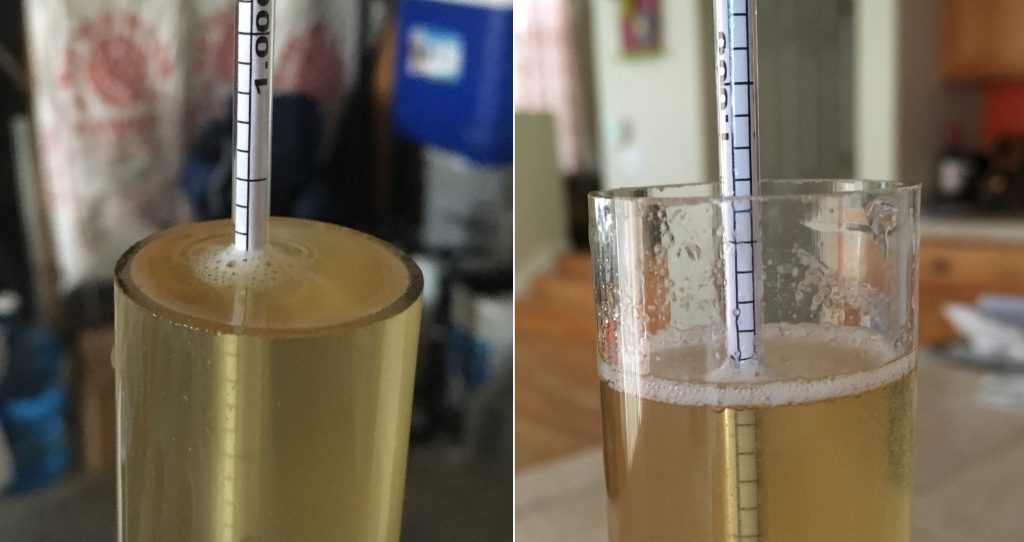
I proceeded to cold crash and fine with gelatin before kegging.

The filled kegs were placed in my keezer where they were burst carbonated then left to condition for about a week. When it came time to collect data, the beers were clear, carbonated, and shared a very similar appearance.
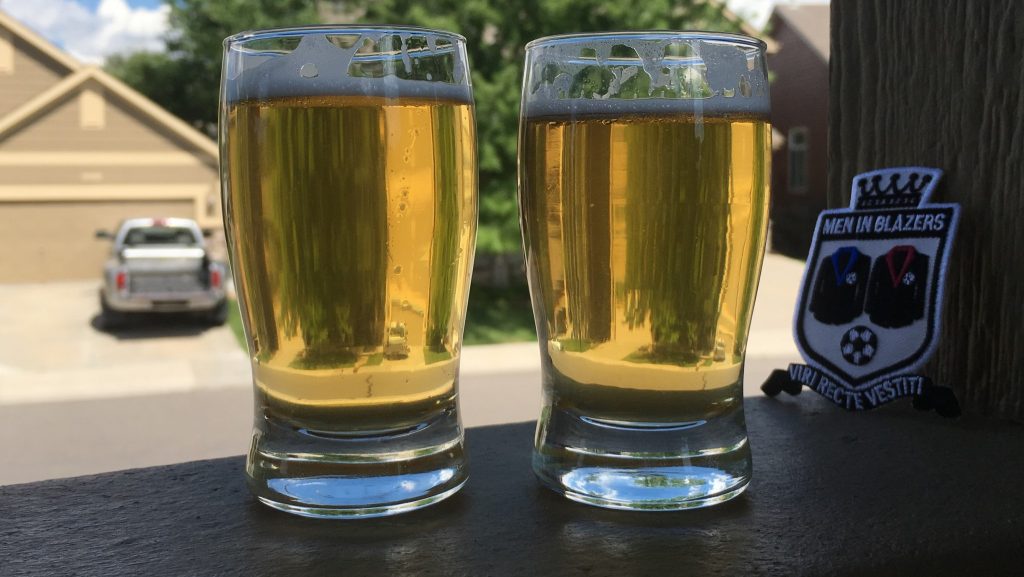
| RESULTS |
Cheers to the Aurora City Brew Club for allowing me to crash a meeting to collect data for this xBmt!
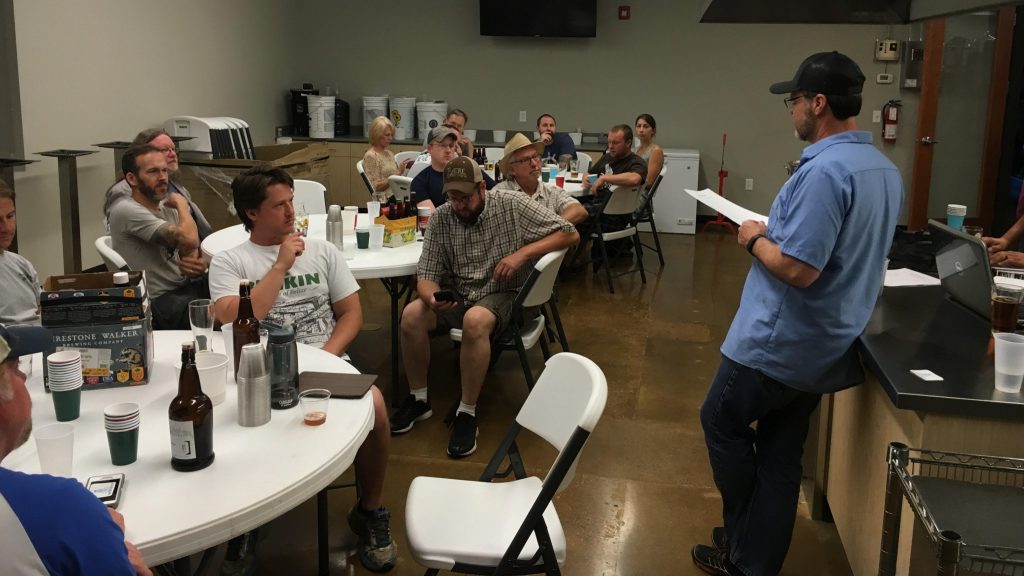
A panel of 29 people of varying levels of experience participated in this xBmt, all blind to the variable being investigated. Each taster was served 2 samples of the vitality starter beer and 1 sample of the viability starter beer in differently colored opaque cups then instructed to select the unique sample. In order to achieve statistical significance at this sample size, 15 participants (p<0.05) would have had to correctly select the viability beer as being different. Ultimately, only 7 tasters (p=0.90) made the accurate selection, suggesting participants could not reliably distinguish a lager pitched with a standard viability starter from one pitched with a vitality starter.
My Impressions: From my first sampling of these beers in a simple side-by-side comparison to later “blind” triangle tests, I’ve been unable to tell them apart, they look, smell, and taste exactly the same to me. And thankfully so, because it’s good beer! The WLP802 Czech Budejovice yeast produced a lager I experienced as being very crisp and clean with the slightest hint of sulfur, a character I desire in this style of beer. The beer portrayed a delicate malt flavor I really enjoyed, though perhaps due to my restrained use of hops, I felt it was closer to an American Lager than a Czech Lager. But whatever, it was dry, refreshing, and infinitely quaffable.
| DISCUSSION |
A very limited amount of information exists on vitality starters, in fact, top results of a Google search for the term point back to our original article on the topic. Because of this, hypotheses are developed based on what’s known about yeast viability and health, our own as well as others’ anecdotal experiences, and of course prior xBmt results, of which there was only one. My personal hunch when going into this xBmt was that a vitality starter would produce a beer no different than a standard viability starter, this given the fact I’ve used them extensively in my brewing and it has always worked very well. What I didn’t expect was the increased lag and extended fermentation in the batch pitched with the vitality starter, as my experience with ales has been vastly different, and this certainly caused me to question whether the beers would be different.
But they weren’t different, at least in terms of appearance, aroma, flavor, and mouthfeel, as a decently sized pool of participants were incapable of reliably distinguishing one from the other. These results provide evidence that lag time may not be all that detrimental when good sanitation practices are used, and may help ease the minds of those who didn’t have time to prepare a standard starter before brew day.
Despite the lack of a perceptible difference, I’m super bummed by these results, I really hoped the vitality starter would perform similarly with cool fermented lager as it does with warm fermented ale. Instead, the time saved on the front-end by not making a viability starter was paid back more than twofold by the extended lag and fermentation time of the vitality starter beer. The fact a lager pitched with 0.25 million cells/ml/°plato was indistinguishable from one pitched with a standard amount of yeast is surprising to me given the seemingly ubiquitous fear brewers have about underpitching, but that was overshadowed by my frustration with the objectively observable difference in fermentation between the batches. I’ll continue to regularly use vitality starters both in my ale brewing and to further explore how they perform with cooler fermented lager beers.
If you’ve used the vitality starter method in your brewing, whether for lager or ale, we’d love to hear form you. Please share your thoughts and experiences in the comments section below!
Support Brülosophy In Style!
All designs are available in various colors and sizes on Amazon!
Follow Brülosophy on:
FACEBOOK | TWITTER | INSTAGRAM
If you enjoy this stuff and feel compelled to support Brulosophy.com, please check out the Support Us page for details on how you can very easily do so. Thanks!


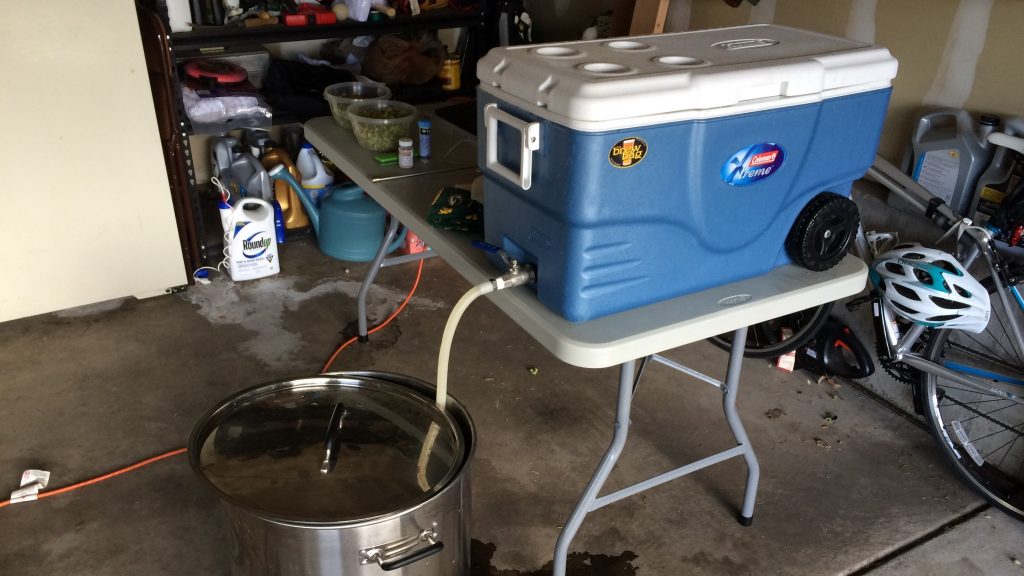
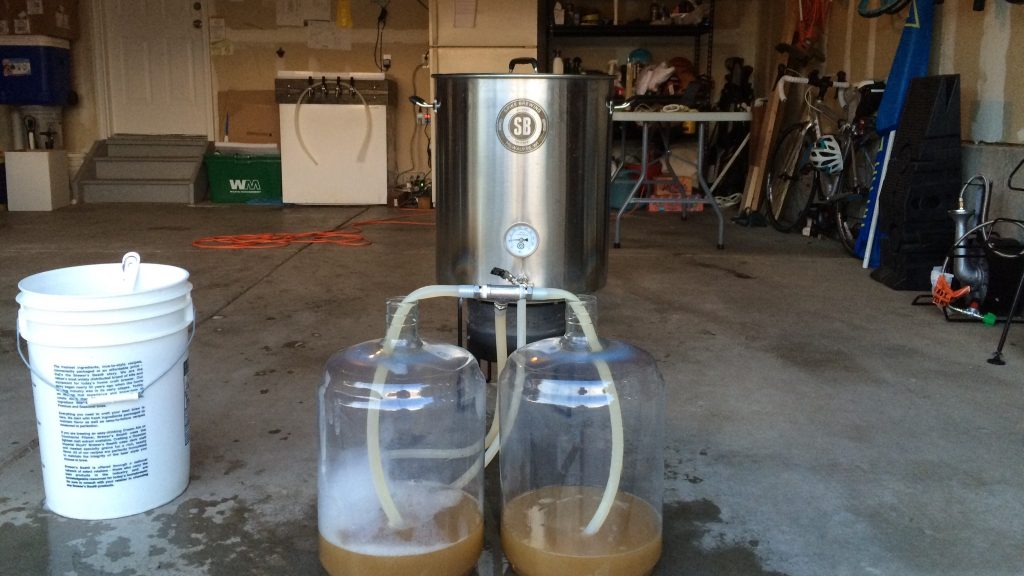
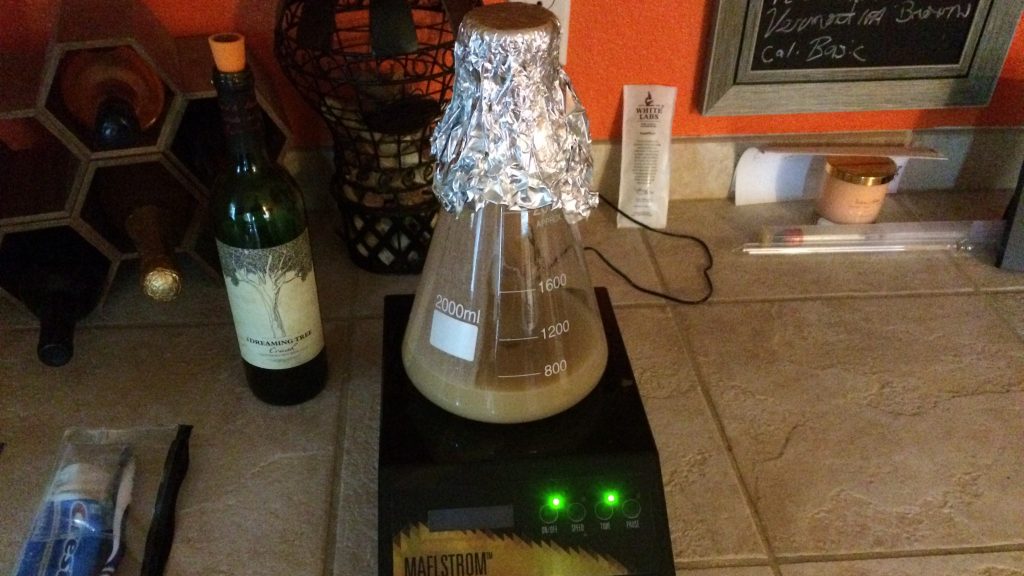
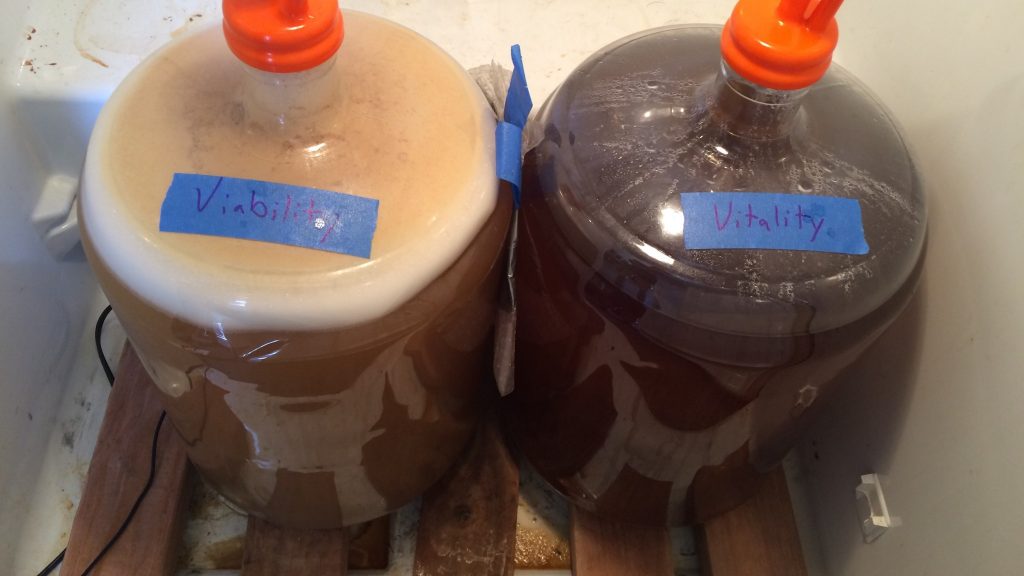
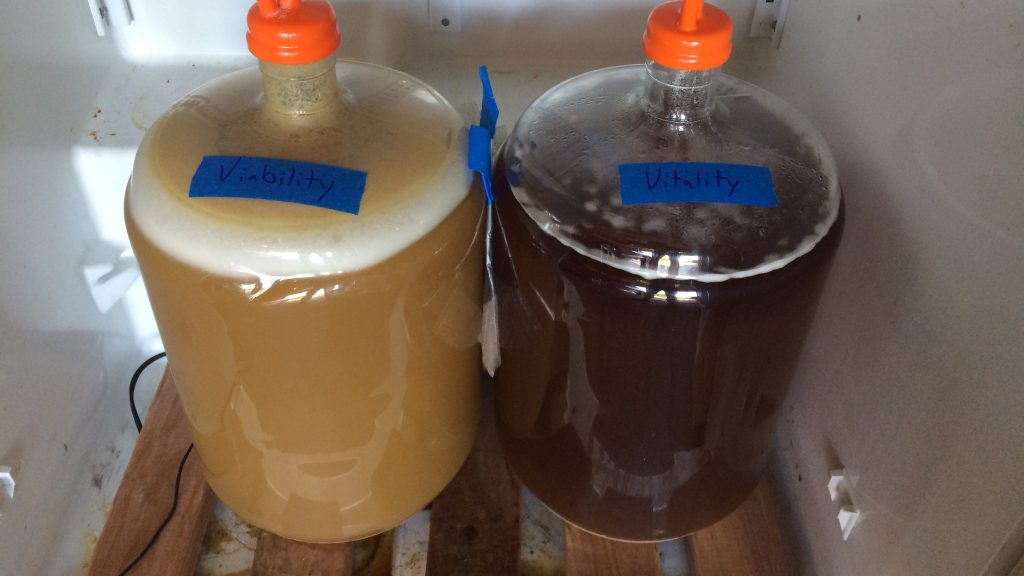
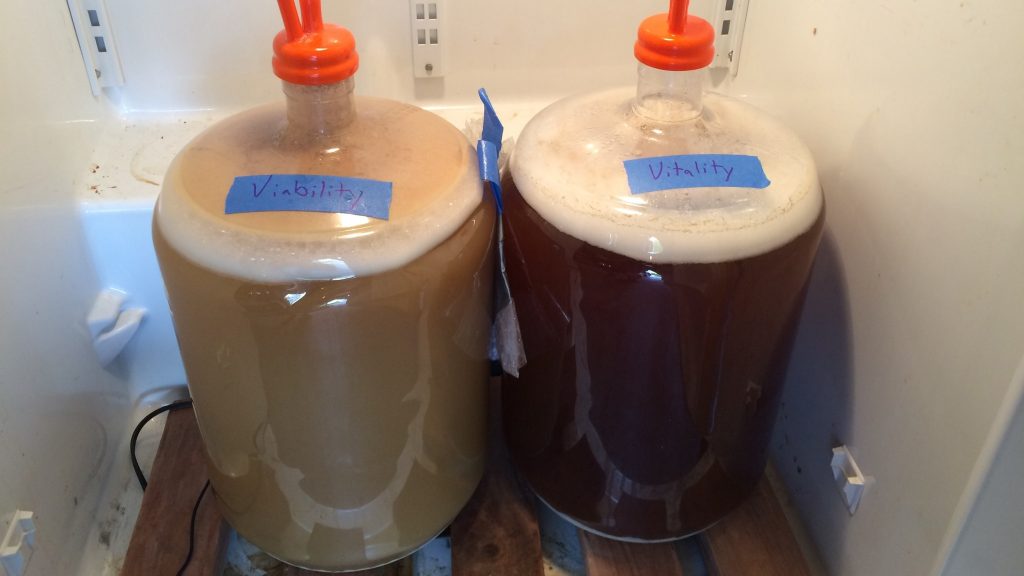
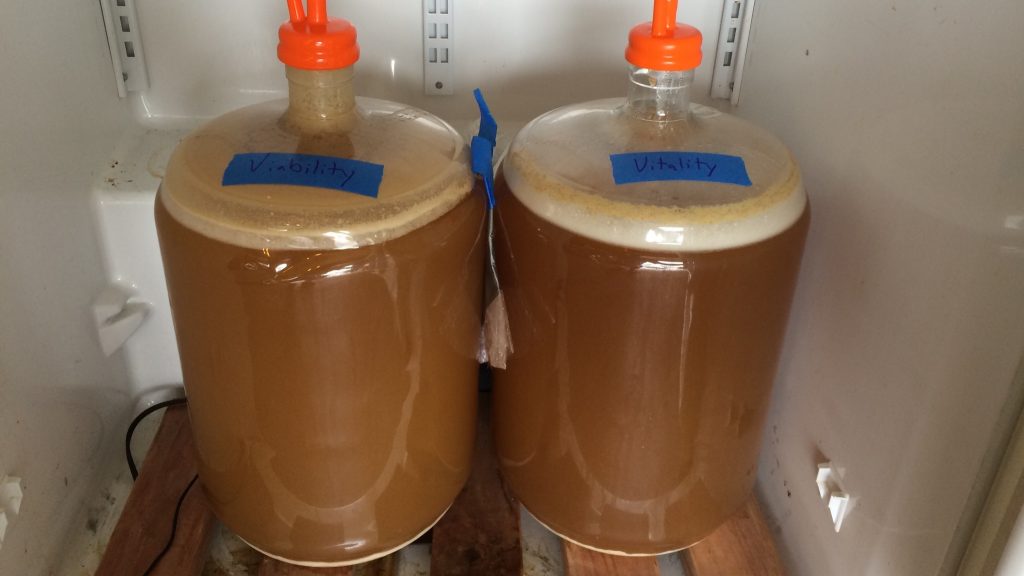











40 thoughts on “exBEERiment | Yeast Pitch Rate: Vitality Starter vs. Viability Starter In A Czech Premium Pale Lager”
Very interesting and informative results there! They seem to support the conventional wisdom of double pitching rates for lagers but only in the sense of quick start and rapid fermentation which obviously didn’t make a difference in your case as far as flavor. I assume this is only because of good sanitation practices. The reasoning being rapid fermentation from the time of pitching helps keep other critters from fermenting your beer, correct?
That’s my understanding. Quick fermentation would consume resources faster than bugs can. Not that I question my sanitation much but it’s kind of comforting to see it play out as intended
Interesting experiment, but I think you used your vitality stater in a non-standard fashion; they are often (usually?) used to resuscitate yeast which has been stored for a long period of time (e.g. a yeast cake stored in the fridge for a few months), so the pitch rate would be closer to normal levels than the yeast numbers you used.
That said, your experiment would suggest that, fermentation time aside, there likely wouldn’t be much of an effect.
I’m just fascinated by the difference in pitch rates producing no perceivable differences in the ending product, to me at least. I preached proper pitch rate for so long, seems like time wasted
My grand theory when it comes to non-significant xbmts is that when you guys tweak a single variable but maintain excellent practices in pretty much every aspect of the brew, fermentation, and packaging, the chances that you’ll have a fermentation go poorly remain pretty minimal. But when lots of best practices are ignored cumulatively by other, less meticulous or poorly equipped homebrewers, the probability that something will chemically or biologically go wrong throughout the process increases. Underpitching, poor/no temperature control, reduced boils, lack of aeration, etc. will not negatively impact the brew 100% of the time, and if you take a shortcut or two every now and then, you’re probably alright.
I dunno look at the short and shoddy brew day xbmts
Yeah, I make vitality starters all the time. I even make them with dry yeast, to reduce shock. But i always start with the correct amount of yeast. They seem to perform almost as well as a liquid starter. I also use old yeast cake to make vitality starters.
I frequently refer to Jamil’s yeast starter chart in his book ‘Yeast’ for sizing starters. Based on 100 billion cells per vial, Jamile recommends pitching 2 fresh vials of yeast into a 4 liter starter in order to grow 400 billion cells; which may be more in line with a 6% lager.
So I use Kai Torester’s growth formula via the Homebrew dad calculator which recommended 1 vial for 2700 ml based on my yeast date at the time. I was recently doing some digging and realized their growth formulas appear to be quite different. Since I’m not doing cell count I have no way to know sadly.
I’ve never done anything but smacked the smack pak a day or two before brew-day, then leave it sitting in some warm starsan water starting on the morning of brew day – usually it is puffed up to the point where I am nervously hoping it does not burst. Usually the fresher yeast look a lot spunkier than the older yeast but they always puff up good.
When I get a 3 day lag I panic – when it’s fermenting away the next morning I celebrate. I have no clue what determines either case and wish I knew…. I suspect maybe temperature difference? The Wort is usually sitting at about 65F when I pitch, the yeast itself is probably at a bit over room temperature, so mid to high 70’s.
I just use about 0.5L of yeast slurry, harvested from the previous batch. Always have a rapid fermention, don’t have to buy yeast, and no prep work before pitching.
Perfect timing for this exbeeriment. I’ve been brewing lots of ales the last couple of months in preparation for a wedding. In anticipation of brewing five batches of a Belgian Dubbel, I propagated enough yeast for all five from a single smack pack. Now I have plenty of experience propagating yeast, having brewed dozens of big lagers, but we were not happy with the resulting Dubbels. They smell like trub, and frankly the taste is quite off as well. We even tried gelatin, but it’s still cloudy, still smells faintly like trub and still tastes off, so we decided we’d re-brew the Dubbels.
This time, instead of growing a huge viability colony (and risking a contaminated colony doing a multi-step starter, which is what we suspect happened to the first four batches), we’ve used one package per batch in a vitality starter, and our results seem to be much better – the Dubbel actually smells like a Dubbel, rather than a yeast cake.
Lately, we’ve been pondering brewing an Oktoberfest for the wedding, since the wedding is in October, and I’ve been wondering if I should try the Vitality starter for the Oktoberfest, given how much easier it’s made ale brewing, but given these results I think I’ll stick with the Viability start if for no other reason than I’d rather spend the time lagering than fermenting.
Very well done. What I’m left wondering is whether the 4-hours of spinning of the vitality starter did anything to get things going in your lager since it ended up taking 3-days to take off. Would you have gotten the same results (albeit slow results) if you had just dumped your vial directly into the wort?
I’m sure it’s on the list, but I’d love to see a similar “pitch count” experiment with heffe yeast. Does under-pitching really “stress” the yeast into different flavor profiles? These experiments would suggest “no”, which sucks because I literally pitched a heffe stain without a starter this morning. Would have done a starter if I had read this last week as I need the fermenter available by next weekend (so no time for an extended lag..)
Assuming cell counts are correct (and there really are 100 billion cells in a White Labs vial), 4x the yeast was pitched into the standard carboy than the vitality carboy. Yeast double in 2h at 30C, but this is slowed down dramatically the lower on temperature you go. So the vitality carboy had to double twice at 9C to get to the point where the other STARTED, all the while the traditional culture is doubling until saturation is reached. No wonder the lag.
I love these pitch rate experiments, by the way.
I would love to see, for the hell of it, standard vs. “pitching” a single colony. That would be the ultimate test of pitch rate. As long as your stuff is sterile you don’t need to fear contamination.
Great stuff Jake.
Oh, by the way, the 2h doubling is for cerevisiae in the lab… No idea what lager yeast doubling time really is.
Based on the estimate of the cell viability of the vials I pitched, and of course those are all estimates as there are tons of variables in the shipping process etc. I believe the vitality beer was pitched with ~60 mil cells of yeast. So the estimated rates were even farther apart than 4X.
That would be a 6000-fold difference in number (13 or so generations). If a white labs pack comes with 100 billion cells, 60 million is like 1/1000th of a full fresh pack. Or am I wrong about their alleged cell count?
Regardless, huge difference in cell number, no difference in taste. Very cool.
Haha I meant billion not million. Sorry
Brulosophy: Making Mondays Great Again.
I completely agree. I actually have something to look forward to on Monday mornings!
“Finally, after 30 fucking days…”
Laughed so hard. Thank you.
The lag time is why I almost always pitch lagers “warm”. Frankly I under pitch, badly in some cases, all the time. Not to pat myself on the back too hard and risk hurting myself, but my brew club often remarks on my beers being very good. The only negatives I’ve gotten have been a couple of out of control carbonations (ops) and a bit of an alkaline bite in a Roggenbier.
Maybe it is because I often under pitch, using a yeast calculator my ales are often close to the proper pitching rate and I never make starters big enough for lagers typically under pitching 40-80%, but the way I get fast “light off” on my fermentations is I’ll pitch my decanted starter with my wort cooled to between 64 and 68F depending on the season. I’ll then stick it in my carboy with the temperature controller set to 62F which usually takes about 30 minutes per degree to get it to a stable temperature. I then let it hold there either until I go to bed or I wake up in the morning depending if I finished brewing at night or in the afternoon. Then I drop it down to 50F if I see good signs of life or if I don’t, I’ll drop it to 56F and check back in a few hours. As soon as I see good signs of life I’ll drop it to 50F.
But then again, fermentation temperature even on lagers seems to not be as important as we used to think. I generally have good activity within 12hrs on my lagers and within 6hrs on my ales. The couple of times I’ve dropped the temperature right away on my lagers I tend to see closer to 16-24hrs of lag time or even a little more.
I like your method of “warm” pitching. I’ve been pitching much warmer than you. I had a microbiologist explain to us about pitching warm for growth. I chill to between 80- 90 degrees F, pitch, and put into my fermentation chamber set to the target temp. Typically I have activity with 12 hours, even with a lager. Great results. Currently my ground temp is about 78*.
How do you like the maelstrom?
I like the timer function a lot. Other than that it’s a stir plate with preset speeds. Never failed me or kicked a bar
I tried a vitality starter for the first time with the Big MACC DIPA that was used on the Xbeeriment here. At 12 hours there were active signs of fermentation and an inch of kreusen, @ 24 about two inches and at 36 it had blown through airlock of my 6.5 gallon carboy despite using Fermicap. and was fermenting like a bastard. I’ve never had anything ferment like that in a high gravity beer! Sold me on vitality starters at least for ales. I’ll have to try one on my next lager. BTW the Big MACC is awesome!
I love vitality starters for ales, only had them perform superbly for me
I have a quick question Jake. Did you oxygenate/aerate your wort?
From the article:
This is interesting… Especially since they taste the same.
I do have a problem with your method, however. You introduced a second variable by NOT oxygenating both beers. I would bet money that is why the vitality took so long to ferment–i.e. not enough O2 for the yeast to grow into a ‘healthy’ colony. I am surprised that this did not produce off-flavors.
So the vitality starter is specifically designed to not require O2 at pitch. After doing a few more pitch rate experiments I’m actually not as surprised by this result, though at the time I was shocked.
That part doesn’t make sense to me. Yeast need O2 to reproduce. You oxygenate on the stirplate for 4 hours which wakes up the yeast and starts their reproduction, but then you add it to the O2 depleted wort halts reproduction. This leaves behind a relatively small colony to ferment the the beer, thus taking much more time to ferment than the batch with a large colony.
My understanding of this is you’re giving the yeast enough o2 on the plate to get going then pitch. It seems based on these results at least, pitch rate plays some sort of component in this process.
It’s interesting. I’ll have to do some more reading on vitality starters.
I just brewed my second lager this past weekend (40+ ales under my belt). I used vitality starters on the last three ales with great results. All previous brews utilized a stirplate and decant (viability) starter. My method for vitality starters for ~1.055 ales: pull 1L of wort at beginning of boil, cool to ~70F, shake to foam in a 1gal container, pitch swollen smack pack, pitch entire starter into mid 60s degree wort 4hrs later or the next morning (wort shaken). I would see fermentation in 12-18 hrs. Supposedly, the max cell density for 1L starter is roughly 200 billion cells. With yeast doubling every 90mins at room temp, each vitality pitch was around 200B cells, recommended pitching rate.
So, I decided to try it with my lagers. And this is where my experience matches yours almost exactly. Ten gallon batch of 1.052 lager, pulled two separate 2L starters, cooled to room temp, shook both to foam in 1gal jugs, pitched swollen smack packs – different lager yeast into separate jugs(each 25-30% viable based on manufacture date). This is where I think I messed up: let starters sit at room temp for about 1hr then put into 48F fermentation chamber with 50F wort over night (12hrs). Based on 2L starters and 90min doubling, I should have been close to the max 400B cells in about 5 hrs. But the vitality starters did not look like the ale vitality starters, no krausen, not cloudy, some yeast sediment. I shook gently, it foamed, released co2, so I thought all was well. Aerated each carboy with pure o2 and pitched entire starter at 48F. Set point 50F. Zero activity for almost 2 days. At 43 hrs, this morning, I have slow airlock activity, and a mix between yeast rafts and a light dusting of krausen on 80% of wort surface. I wonder how things would be different if I let the starters ride at room temp (low 70s). I think the 48F greatly affected the yeasts doubling time, and I pitched much less than 400B cells per 5 gal carboy. Does anyone know yeast doubling time at lager temps? Your results calmed me and gave me hope! Thanks.
Yeast divide every 90-120 minutes at 30C. Putting your starter into the fermentation chamber dramatically reduced their rate of cell division, hence your problem. I guess I didn’t answer your question since I don’t know the doubling time at lager temperatures, but I can confirm your suspicion.
You know what… forget I said that. The info I gave was for cerevisiae; I don’t whether the doubling times of lager yeast varies from cerevisiae.
Nice article. Do you think this would also benefit dry yeast? I’m especially enthused about reducing lag time and therefor reducing infection risks.
I do think that dry yeast would benefit from a vitality starter as well.
Would it be crazy if I made the vitality starter using only a sample of the wort, avoiding changes in the OG during dilution?